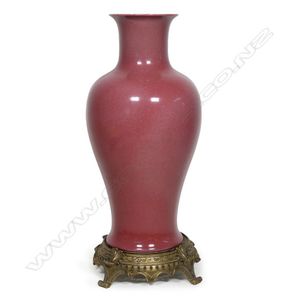Chinese Peach Bloom Vase on Ormolu Stand
A large Chinese peach bloom baluster vase, the recessed base and interior reserved in white, the exterior with a strawberry toned peach bloom glaze. The base with an eight-character underglaze blue mark translating as 'Kang xi yi you ya yu zhi' or 'Made with fine jade elegance during the yi you of the Kangxi reign' but of a later date. On a gilt bronze ormolu stand, height 47 cm excluding stand.
You must be a subscriber, and be logged in to view price and dealer details.
Subscribe Now to view actual auction price for this item
When you subscribe, you have the option of setting the currency in which to display prices to $Au, $US, $NZ or Stg.
This item has been sold, and the description, image and price are for reference purposes only.
- Peach Bloom - Peach bloom glaze is a type of ceramic glaze that was commonly used in Chinese pottery during the 18th and 19th centuries. It is a type of monochrome glaze that ranges in colour from pale pink to deep red, resembling the colour of a peach blossom.
The glaze is created using a combination of iron oxide and copper oxide, which are mixed together in specific proportions and applied to the ceramic surface. The glaze is then fired in a kiln at a high temperature, which causes the iron and copper oxides to interact and create the characteristic range of colours.
Peach bloom glaze is known for its delicate, translucent quality, which allows the underlying ceramic body to show through in places. It was used to decorate a range of ceramics, from small vases to large bowls and plates. The technique was particularly popular during the Qing Dynasty. - Bronze - An alloy of copper and tin, traditionally in the proportions of about 9 parts of copper to 1 part of tin.
The discovery of bronze in Western Asia in the 4th century enabled people to create metal objects which were superior to those previoulsy possible because of its strength and hardness, and it has been used throughout the world for weapons, coins, tools, statuary and other decorative items.
It is very fluid in a molten state, and its hardness, strength when set, and non-corrosive properties makes it most suitable for casting sculpture. - Ormolu - Ormolu was popular with French craftsmen in the 18th and 19th century for ornamental fittings for furniture, clocks and other decorative items. True ormolu is gilt bronze, that is bronze that has been coated with gold using a mercury amalgam. Due to the health risks associated with using mercury, this method of creating ormolu was discontinued in France in the 1830s. A substitute was developed consisting of about 75% copper and 25% zinc, however it was inferior to the bronze version. It was often lacquered to prevent it tarnishing.
This item has been included into following indexes:
- Chinese ceramics, dynasty mark or period
- Chinese ceramics, item type - vases, other 2,540
